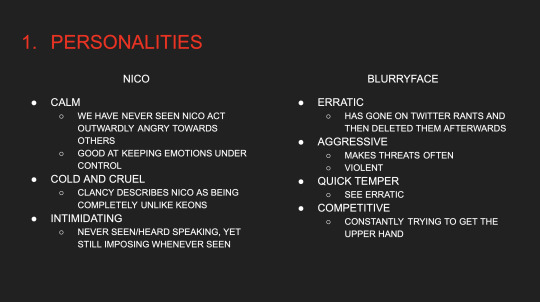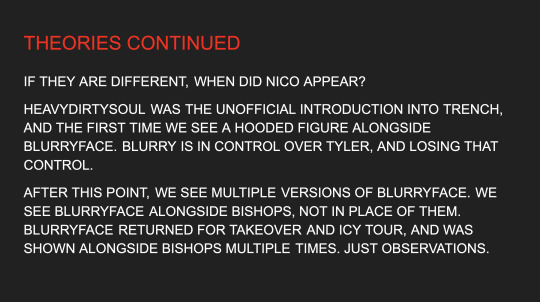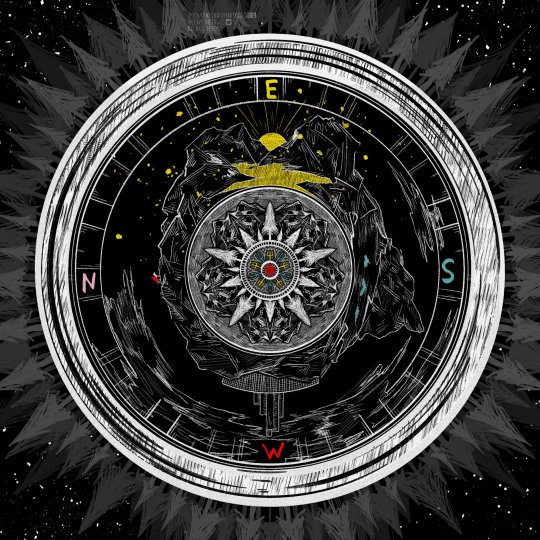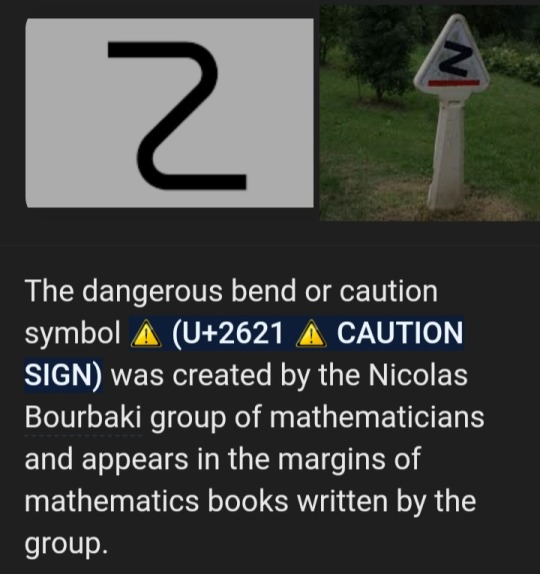#nicolas bourbaki
Text

New lock screen💪
Can you tell I love them??
#tøp clique#tyler joseph#josh dun#skeleton clique#clique#i am clancy#scaled and icy#dema#blurryface#nicolas bourbaki#nico#twenty one pilots clique#twenty one pilots#twenty øne piløts
102 notes
·
View notes
Text
playing Morph in the car with my dad and he said “who is Nicolas Bourbaki…..who is Clancy?” who’s gonna explain it all to him
21 notes
·
View notes
Video
youtube
When Clancy confronts Nico (Twenty One Pilots animation)
I made this, please check it out
#twenty one pilots#twenty øne piløts#top#clancy#tyler joseph#nico#nicolas bourbaki#breakdancing cat#meme#funny#animation#fan animation#skeleton clique#tøp clique
16 notes
·
View notes
Text

whys he drooling
23 notes
·
View notes
Text
i could be working on several other things but no here i am making presentations about my theories. i'm normal (clearly lying to himself).
anyways here is my presentation on why i do not think nico and blurryface are the same person. enjoy.









#twenty one pilots#nicolas bourbaki#blurryface#dema#twenty one pilots theory#my theories#blurry thoughts#blurryface.txt
29 notes
·
View notes
Text
_e_ast _is u__p?


// day 15 - lost
#cliquetober#clique#clique art#twenty one pilots#21 pilots#21p#top#dema#nico#nicolas bourbaki#trench#voldsoy#trash#trash the dragon#compass#east is up
56 notes
·
View notes
Text
I think i finally got why people back in 2016 used to criticize top for "overusing" autotune. they were complaining about the Blurryface parts in blurryface. and let me just say that is idiotic. it's like complaining about Hannibal Lecter killing people. that's the whole point! Some bits in blurryface are unnerving and distorted because Blurryface himself is unnerving and distorted!
6 notes
·
View notes
Text
i love how when joshler Discourse begins to happen on twt tyler doesn't have to do anything he just subtly tells antis to Know their place
#clique is for joshler shippers and joshler shippers only#no matter platonic or not#rpf this rpf that what about tyler writing nicolas bourbaki rpf
8 notes
·
View notes
Text
what if i made last minute trench/cliquetober art instead of writing this essay
6 notes
·
View notes
Text
uhhhhh the dangerous bend symbol was invented by NICOLAS BOURBAKI??

am i stupid?? is this already common knowledge? pls tell me
86 notes
·
View notes
Photo



me and my friends would’ve killed nicolas bourbaki with hammers i’ll tell you that much
#late blurry day art i sory......#i missed drawing spooky!!!!!!!!!! My wife#twenty one pilots#blurryface#spooky jim#tyler joseph#josh dun#clique art#art tag
380 notes
·
View notes
Text
okay now that i've listened to it hundreds of times over the past day i have thoughts
the opening notes are so trench and so blurryface it makes me want to go feral
WELCOME BACK TO TRENCH MY BELOVED
the banditos opening had me nearly sobbing at the premiere. special harmony emphasis on "Destroy it if i want"???
the TEMPO and beat change gets me shmovin'
car horn in the bg? would fit the timeline of HDS and Levitate
not me thinking "wait, what?" was "we won" smh
ear holes is a very. interesting way of putting that, mr clancy tyler sir
did this man just say gobsmacked.
"don't sleep on a boy who can fall asleep twice in the same night..." could be referring to seizing? maybe clancy has a better version of seizing than the bishops have? is there a limit to how many bodies you can seize?
the melody here is so goddamn pretty.
something something dangerous bend symbol something something nicolas bourbaki mathematics group
oh god not themes of rebirth. the religious trauma is gonna hurt in this one.
STRAIGHT UP "I AM CLANCY" LETS GO
"prodigal son, done running" HOLY FUCK AAAAAA
"come up with josh dun" hello good sir are you trying to make me cry
uhhhhh save half for my taxes then overtake my former self???? what do you mean by this???
this bridge is SO GOOD. little taste of clancy tyler rap and the spanish too UGH
WAY TOO SHORT FOR MY SOUL, CORAZÓN AAAAGH
gobsmacked is now added to my dictionary
there are my thoughts you're welcome
#banditos#tøp7#twenty one pilots#trench#blurryface#scaled and icy#tøp clique#overcompensate#clancy#clancy is alive and fucking ATE
17 notes
·
View notes
Text
I know it's not like that but it would be cool if Sampo was just a mask the Fools took turns to wear. A shared persona, like Nicolas Bourbaki in mathematics (a pseudonym of a bunch of mathematicians and one of the most influential, even if nonexistant figures in 20th century mathematics).
The type of humour would fit too.
Humor has been an important aspect of the group's culture, beginning with Weil's memories of the student pranks involving "Bourbaki" and "Poldevia". For example, in 1939 the group released a wedding announcement for the marriage of "Betti Bourbaki" (daughter of Nicolas) to one "H. Pétard" (H. "Firecrackers" or "Hector Pétard"), a "lion hunter". Hector Pétard was itself a pseudonym, but not one originally coined by the Bourbaki members. The Pétard moniker was originated by Ralph P. Boas, Frank Smithies and other Princeton mathematicians who were aware of the Bourbaki project; inspired by them, the Princeton mathematicians published an article on the "mathematics of lion hunting". After meeting Boas and Smithies, Weil composed the wedding announcement, which contained several mathematical puns. Bourbaki's internal newsletter La Tribu has sometimes been issued with humorous subtitles to describe a given conference, such as "The Extraordinary Congress of Old Fogies" (where anyone older than 30 was considered a fogy) or "The Congress of the Motorization of the Trotting Ass" (an expression used to describe the routine unfolding of a mathematical proof, or process).
During the 1940s–1950s, the American Mathematical Society received applications for individual membership from Bourbaki. They were rebuffed by J.R. Kline who understood the entity to be a collective, inviting them to re-apply for institutional membership. In response, Bourbaki floated a rumor that Ralph Boas was not a real person, but a collective pseudonym of the editors of Mathematical Reviews with which Boas had been affiliated. The reason for targeting Boas was because he had known the group in its earlier days when they were less strict with secrecy, and he'd described them as a collective in an article for the Encyclopædia Britannica. In November 1968, a mock obituary of Nicolas Bourbaki was released during one of the seminars.
from Wikipedia
8 notes
·
View notes
Text
DANGEROUS BEND SIGN LIKE NICOLAS BOURBAKI GROUPS SYMBOL FJKDhKHLAKDHKLHD I LOVE THE NICOLAS BOURBAKI LOREEEEEEEEE
7 notes
·
View notes
Text
I don't think that people who care more about credit for their work than they do about the work itself are usually involved in anything worthwhile. Be more like Euclid of Alexandria or Nicolas Bourbaki.
11 notes
·
View notes
Text
The 1973 masterpiece, Goncharov, has gone from celebrated, forgotten and now celebrated once again, suddenly emerging from obscurity. Given the cenematric importance of The Godfather in 1974, also directed by Scorsese, Jaws, directed by Spielberg in 1975, Rocky, directed by Avildsen in 1976 and Star Wars directed by Lucas in 1977, it is understandable that by 1978, there is almost no mention of Goncharov in cinema reviews or even textbooks. Only in academic journal articles and infrequent expansive reviews of gangster movies by critics who remember the excitement of Goncharov when it first appeared will you find any mention of the film. Yet, in the past year, perhaps because of increasing celebration of Scorsese’s oeuvre, has the title “Goncharov“ appeared again in print.
One facet of the making of Goncharov that seems to have been missed, both in the 1970’s and now, is its intersection with mathematics. When scouting for film locations in Paris, Scorsese happened across a cafe near the École Normale Supérieure. Apparently, he ducked into the cafe to get out of an unseasonably cold weather. He struck up a conversation with a gentleman who happened to be none other than Nicolas Bourbaki, the mathematician who was a professor at ENS. Bourbaki is noted for his many textbooks starting in 1934 that were instrumental in the modernization of pure mathematics. The two became fast friends. Bourbaki and Scorsese took to having dinner and a long walk afterward every evening for the remainder of the three weeks Scorsese was in Paris. Bourbaki pointed out mathematics in nature on these evening walks, especially regarding proportions.
For example, if one looks at branches on a tree, where the branches emerge from the trunk, it forms a spiral along the trunk, considering one branch to the next moving upward. This spiral will wrap around the trunk after a certain number of branches. The ratio of these numbers is consistent for a species of tree. An elm tree has a ratio of 1 to 2. That is, the spiral wraps once around the trunk every two branches. A beech tree has a ratio of 1 to 3. The willow tree has a ratio of 3 to 8. An almond tree has a ratio of 5 to 13. The oak tree, which is plentiful in Paris, has a ratio of 2 to 5.
These spiral tree ratios come from the Fibonacci sequence, namely the infinite list that begins 1, 1, 2, 3, 5, 8, 13, 21, 54, … The first two numbers in the list are 1 and 1. After that, each new number in the list is the sum of the prior two values. The spiral ratios of trees are always made up of two numbers in the Fibonacci sequence that are two apart. So 1 and 2, then 1 and 3, then 2 and 5, then 3 and 8, etc.
The seeds of a pine cone ascend in a spiral. The spiral goes in both directions. If one counts the number of pine seeds along a pine cone, the number of rows of seeds depends on which direction you are counting along the pine cone. Those two numbers will always be successive Fibonacci numbers. This is true also for the double spiral of seeds in a sunflower and the little square-ish units on the skin of a pineapple.
In music, if the frequency of two notes is made up of successive Fibonacci numbers, then we have a special name for the interval. Two notes whose frequency is in a ratio of 1 to1 are in unison. In a ratio of 1 to 2 are an octave apart. In a ratio of 2 to 3 are a fifth apart. In a ratio of 3 to 5 are a fourth apart. The value of the ratio of successive terms in the Fibonacci sequence gets closer and closer to a particular value known as the golden ratio which is about 0.6180.
Beyond discussing the golden ratio, Scorsese and Bourbaki also talked about other proportions like the silver ratio which plays a large role in Chinese and Japanese classical art. They discussed other constants, such as Euler’s number, e, which appears naturally in Calculus with simple questions about area as well as in finance with continuous compounding and in solutions to the motion of springs, electrical circuits and vibrations of molecules. They talked about the Euler’s constant, denoted with a Greek gamma, which appears in applications from information theory to celestial mechanics. Beyond importance in applications, Bourbaki impressed upon Scorsese that proportions are important to aesthetics. He apparently used the music of Bella Bartok as a motivating example.
That meeting took place in 1972. Late that year, Scorsese had started filming in Rome and a few outlying villages that substituted as backdrops for Sicily. In November of that year, Scorsese invited Bourbaki to Rome to visit the set. Bourbaki arrived a few days later by train. The day after that, Bourbake had an uncredited cameo in the now-famous scene with Cybill Shepherd, Harvey Keitel and a very sharp knife.
After filming was completed in early 1973, Scorsese went to work editing Goncharov. Most of the scenes from Paris ended up on the cutting room floor. The cameo of Bourbaki made it into the movie, thankfully. And Scorsese set the peak moments of action and the climax of the story using the golden ratio. The running time of the film is 212 minutes. The (emotional) climax is at 131 minutes. The ratio of 131 to 212 is 0.6179 and the golden ratio is 0.6180. The ticking clock image appears in the movie six times (“time is running out”). It appears in fact, every 34 minutes and 38 seconds with intense precision. The Euler constant, gamma, is about 0.5772. That portion of an hour is 34 minutes and 38 seconds.
Almost as a send up to his friend, Scorsese has the silver bullion removed from the bank vault at 87 minutes and 49 seconds which represents the silver ratio (about 0.4143) to the whole film. At one over e, Euler’s number, (0.3679) which is about a third of the way through the film at 78 minutes, is when we meet the Accountant. Recall that Euler’s number is connected with finance, among other applications. These are not accidents. Scorsese experimented with these proportions with abandon in Goncharov. He apparently learned a great deal since many of these ratios appear in multiple ways in subsequent movies.
Critic, Michael Koresky says of After Hours (Scorsese, 1985) “The nearly mathematical precision of After Hours was the result of a controlled yet rejuvenating movie shoot.” He is incorrect. The mathematical precision is not “nearly” anything. It is exact mathematical precision of proportions used in service to Scorsese’s vision.
There is nothing in interviews or biographical material to suggest that Scorsese and Bourbaki met again after the making of Goncherov. Bourbaki’s work does not seem to be impacted by meeting Scorsese. For example, he does not write about films or proportions in service to narrative. Bourbaki’s output is prodigious through the 1950’s (except the war years) and he continued to publish intermittently after 1960. His most recent known work, as a centenarian for sure, was in 2016 on Algebraic Topology. The inscription of what is likely to be Bourbaki’s last work reads, “Pour Martin et nos promenades du soir.” (For Martin and our evening walks.) Perhaps Goncharov left its mark on Bourbaki, after all.
-- Sam Kaplan, Ph.D. in “Mathematical Sagacity” December 2022.
#goncharov#goncharov (1973)#math#mathematics#film history#yall my REAL ACTUAL father wrote this of his OWN volition#and asked me to post it#So you guys better reblog or my dad will know I'm not cool online#martin scorsese#the z part
83 notes
·
View notes